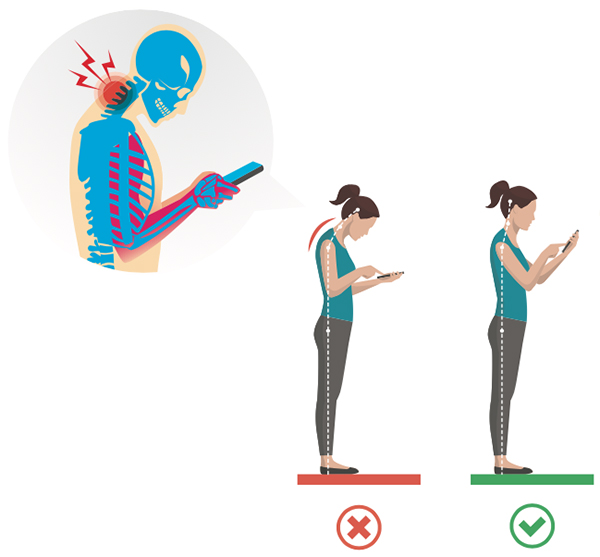Don’t let time looking at your phone spoil your posture.
Have you been travelling on the MTR or in a taxi and not noticed that you arrived at your destination? Have you been bumping into people you didn’t see coming? Have you almost fallen down because of a step you missed?

A common reason for all this happening is that your nose is stuck in your phone, scrolling for the latest Facebook update, last minute emails or writing reports.
Hong Kong is known for its busy life and connected people. In 2016, the Census and Statistic Department of Hong Kong found that 96 per cent of the population aged over 10 years old had a smartphone, 82 per cent of teenagers (10-14 years) and 99 per cent of adults (20-49 years).
‘Text Neck’ is a modern term to describe an overuse syndrome, or repeated stress injury, caused by an excessive forward or downward head position on handheld devices for an extend period of time.
It causes chronic neck pain, upper back, shoulder pain, headaches and increases your thoracic kyphosis.
Symptoms of ‘Text Neck’
Holding your head in the ‘texting’ position creates an excessive amount of tension in the deep neck muscle. The normal average force applied on the spine is about 10-12lb (4.5/5.5kg). Tilting your head forward 15 degrees is enough to increase the force on your spine by 125 per cent. This comes with visible physical symptoms like:
- Stiff neck, soreness and difficulty to move it, especially after long static posture.
- Nagging or sharp pain and even chronic pain (when it lasts more than three months).
- Radiating pain towards the head and/or the shoulders, upper back.
- Headache that is easily triggered by looking down/forward while using a device.
Invisible Symptoms Like:
- Cervical disc compression
- Muscle weakness
- Early onset of arthritis
Management of ‘Text Neck’
A few tips to help avoid further issues or worsening your condition:
- Hold the device at your eye level or slightly under to release the force applied on the spine.
- Avoid long static posture.
- Take a break as often as you can, every 30 minutes to change your posture and stretch your neck.
Physical Therapy can help you to get rid of bad habits by giving you a personalised programme on how to improve your posture, increase neck straightening and strengthening.
Be proud! Heads Up! Here is a great video about the benefits of good posture.
Look out for your children on their phone, growing with that posture could damage their spine and create neck and back pain in their life long-term.
By Magali Salgodo, a physiotherapist at The Round Clinic











